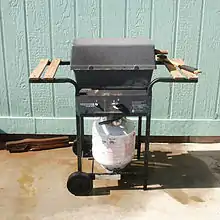Barbecue grill
A barbecue grill is a device that cooks food by applying heat from below. There are several varieties of grills, with most falling into one of three categories: gas-fueled, charcoal, or electric. There is debate over which method yields superior results.[1][2]
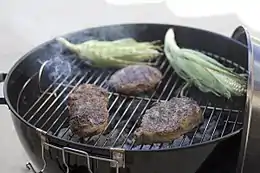
History in the Americas
Grilling has existed in the Americas since pre-Colonial times. The Arawak people of South America roasted meat on a wooden structure called a barbacoa in Spanish.[3] For centuries, the term barbacoa referred to the wooden structure and not the act of grilling, but it was eventually modified to "barbecue". It was also applied to the pit-style cooking techniques now frequently used in the southeastern United States. Barbecue was originally used to slow-cook hogs; however, different ways of preparing food led to regional variations.[4] Over time, other foods were cooked in a similar fashion, with hamburgers and hot dogs being recent additions.[5]
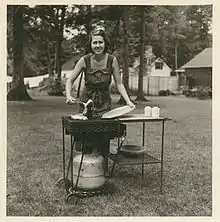
Edward G. Kingsford invented the modern charcoal briquette.[6] Kingsford was a relative of Henry Ford who assigned him the task of establishing a Ford auto parts plant and sawmill in northern Michigan, a challenge that Kingsford embraced. The local community grew and was named Kingsford in his honor. Kingsford noticed that Ford's Model T production lines were generating a large amount of wood scraps that were being discarded. He suggested to Ford that a charcoal manufacturing facility be established next to the assembly line to process and sell charcoal under the Ford name at Ford dealerships. Several years after Kingsford's death, the chemical company was sold to local businessmen and renamed the Kingsford Chemical Company.
George Stephen[7] created the iconic hemispherical grill design, jokingly called "Sputnik" by Stephen's neighbors. Stephen, a welder, worked for Weber Brothers Metal Works, a metal fabrication shop primarily concerned with welding steel spheres together to make buoys. Stephen was tired of the wind blowing ash onto his food when he grilled so he took the lower half of a buoy, welded three steel legs onto it, and fabricated a shallower hemisphere for use as a lid. He took the results home and following some initial success, started the Weber-Stephen Products Company.
The gas grill was invented in the late 1930s by Don McGlaughlin, owner of the Chicago Combustion Corporation, known today as LazyMan.[8] McGlaughlin invented the first built-in grill from the successful gas broiler called BROILBURGER. These first Lazy-Man grills were marketed as "open-fire charcoal-type gas broilers" which featured "permanent coals", otherwise known as lava rock.[9] In the 1950s, most residential households did not have a barbecue, so the term broiler was used for marketing purposes to commercial establishments. The gas open-broiler design was adapted into the first portable gas grill in 1954 by Chicago Combustion Corporation as the Model AP. McGlaughlin's portable design was the first to feature the use of the 20-lb propane cylinders, which previously were exclusively used by plumbers as a fuel source.[10]
Electric grill
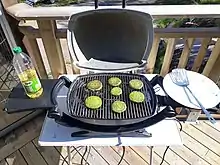
With an electric grill, the heating comes from an electric heating element. Neither coal nor briquettes is needed.
Gas grills
Gas-fueled grills typically use propane or butane (liquified petroleum gas) or natural gas as their fuel source, with the gas flame either cooking food directly or heating grilling elements which in turn radiate the heat necessary to cook food. Gas grills are available in sizes ranging from small, single steak grills up to large, industrial sized restaurant grills which are able to cook enough meat to feed a hundred or more people. Some gas grills can be switched between using liquified petroleum gas and natural gas fuel, although this requires physically changing key components including burners and regulator valves.
The majority of gas grills follow the cart grill design concept: the grill unit itself is attached to a wheeled frame that holds the fuel tank. The wheeled frame may also support side tables, storage compartments, and other features.
A recent trend in gas grills is for manufacturers to add an infrared radiant burner to the back of the grill enclosure. This radiant burner provides an even heat across the burner and is intended for use with a horizontal rotisserie. A meat item (whole chicken, beef roast, pork loin roast) is placed on a metal skewer that is rotated by an electric motor. Smaller cuts of meat can be grilled in this manner using a round metal basket that slips over the metal skewer.
Another type of gas grill gaining popularity is called a flattop grill. According to Hearth and Home magazine, flattop grills "on which food cooks on a griddlelike surface and is not exposed to an open flame at all" is an emerging trend in the outdoor grilling market.[11]
A small metal "smoker box" containing wood chips may be used on a gas grill to give a smoky flavor to the grilled foods. Barbecue purists would argue that to get a true smoky flavor (and smoke ring) the user has to cook low and slow, indirectly and using wood or charcoal; gas grills are difficult to maintain at the low temperatures required (~225-250 °F), especially for extended periods.
Infrared grills
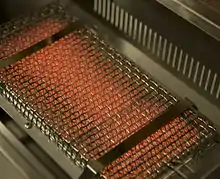
Infrared grills work by igniting a gas fuel to heat a ceramic tile, causing it to emit infrared radiation by which the food is cooked. The thermal radiation is generated when heat from the movement of charged particles within atoms is converted to electromagnetic radiation in the infrared heat frequency range. Infrared grills allow users to more easily adjust cooking temperature than charcoal grills, and are usually able to reach higher temperatures than standard gas grills, making them popular for searing items quickly.[12]
Charcoal grills
Charcoal grills use either charcoal briquettes or natural lump charcoal as their fuel source.[13] When burned, the charcoal will transform into embers radiating the heat necessary to cook food.
There is contention among grilling enthusiasts on what type of charcoal is best for grilling. Users of charcoal briquettes emphasize the uniformity in size, burn rate, heat creation, and quality exemplified by briquettes. Users of all-natural lump charcoal emphasize its subtle smoky aromas, high heat production, and the lack of binders and fillers often present in briquettes.
There are many different charcoal grill configurations. Grills can be square, round, or rectangular, some have lids while others do not, and they may or may not have a venting system for heat control. The majority of charcoal grills, however, fall into the following categories:
Brazier

The simplest and most inexpensive of charcoal grills, the brazier grill is made of wire and sheet metal and composed of a cooking grid placed over a charcoal pan. Usually the grill is supported by legs attached to the charcoal pan. The brazier grill does not have a lid or venting system. Heat is adjusted by moving the cooking grid up or down over the charcoal pan. Even after George Stephen invented the kettle grill in the early 1950s, the brazier grill remained a dominant charcoal grill type for a number of years. Brazier grills are available at most discount department stores during the summer.[14]
Pellet grill
Pellet grills are fueled by compressed hardwood pellets (sawdust compressed with vegetable oil or water at approx. 10k psi) that are loaded into a hopper and fed into a fire box at the bottom of the grill via an electric powered auger that is controlled by a thermostat. The pellets are lit by an electric ignitor rod that starts the pellets burning and they turn into coals in the firebox once they burn down. Most pellet grills are a barrel shape with a square hopper box at the end or side.
The advantage of a pellet grill is its temperature versatility. It can be set on a "smoke" mode where it burns at 100–150 °F (38–66 °C) for slow smoking. It can also be set at 180–350 °F (82–177 °C) to slow cook or barbecue meats (like brisket, ribs and hams) or cranked up to a temperature of 450–500 °F (232–260 °C) for what would be considered low temperature grilling. Some high-end pellet grills can reach up to 700 °F (371 °C) for searing. It is one of the few grills that is actually a smoker, a barbecue and a grill. The best pellet grills can hold steady temperatures for more than ten hours. Many use solid diffuser plates between the firebox and grill to provide even temperature distributions.
Most pellet grills burn 1/2 to 1 pound of pellets per hour at 180–250 °F (82–121 °C), depending on the "hardness" of the wood, ambient temperature and how often the lid is opened. Most hoppers hold 10 to 20 pounds of wood pellets. Pellets in a wide variety of woods including:hickory, oak, maple, apple, alder, mesquite, and grapevine, etc., and can be used, or mixed, for desired smoke flavoring.
Pellet technology is widely used in home heating in certain parts of North America. Softer woods including pine are often used for home heating. Pellets for home heating are not cooking grade and should not be used in pellet grills.[15]
Square charcoal
The square charcoal grill is a hybrid of the brazier and the kettle grill. It has a shallow pan like the brazier and normally a simple method of adjusting the heat, if any. However, it has a lid like a kettle grill and basic adjustable vents. The square charcoal grille is, as expected, priced between the brazier and kettle grill, with the most basic models priced around the same as the most expensive braziers and the most expensive models competing with basic kettle grills. These grills are available at discount stores and have largely displaced most larger braziers. Square charcoal grills almost exclusively have four legs with two wheels on the back so the grill can be tilted back using the handles for the lid to roll the grill. More expensive examples have baskets and shelves mounted on the grill.
Shichirin (hibachi)
The traditional Japanese hibachi is a heating device and not usually used for cooking. In English, however, "hibachi" often refers to small cooking grills typically made of aluminum or cast iron, with the latter generally being of a higher quality. Owing to their small size, hibachi grills are popular as a form of portable barbecue. They resemble traditional, Japanese, charcoal-heated cooking utensils called shichirin.
Alternatively, "hibachi-style" is often used in the U.S. as a term for Japanese teppanyaki cooking, in which gas-heated hotplates are integrated into tables around which many people (often multiple parties) can sit and eat at once. The chef performs the cooking in front of the diners, typically with theatrical flair—such as lighting a volcano-shaped stack of raw onion hoops on fire.
In its most common form, the hibachi is an inexpensive grill made of either sheet steel or cast iron and composed of a charcoal pan and two small, independent cooking grids. Like the brazier grill, heat is adjusted by moving the cooking grids up and down. Also like the brazier grill, the hibachi does not have a lid. Some hibachi designs have venting systems for heat control. The hibachi is a good grill choice for those who do not have much space for a larger grill, or those who wish to take their grill traveling. Binchō-tan is most suitable for fuel of shichirin.
Kettle
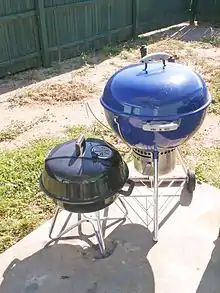
The kettle grill is considered the classic American grill design. The original and often-copied Weber kettle grill was invented in 1951 by George Stephen. It has remained one of the most commercially successful charcoal grill designs to date. Smaller and more portable versions exist, such as the Weber Smokey Joe. The kettle grill is composed of a lid, cooking grid, charcoal grid, lower chamber, venting system, and legs. Some models include an ash catcher pan and wheels. The lower chamber that holds the charcoal is shaped like a kettle, giving the grill its name. The key to the kettle grill's cooking abilities is its shape. The kettle design distributes heat more evenly. When the lid is placed on the grill, it prevents flare-ups from dripping grease, and allows heat to circulate around the food as it cooks. It also holds in flavor-enhancing smoke produced by the dripping grease or from smoking wood added to the charcoal fire.
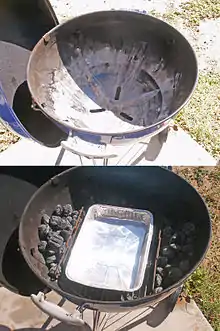
The kettle design allows the griller to configure the grill for indirect cooking (or barbecuing) as well. For indirect cooking, charcoal is piled on one or both sides of the lower chamber and a water pan is placed in the empty space to one side or between the charcoal. Food is then placed over the water pan for cooking. The venting system consists of one or more vents in the bottom of the lower chamber and one or more vents in the top of the lid. Normally, the lower vent(s) are to be left open until cooking is complete, and the vent(s) in the lid are adjusted to control airflow. Restricted airflow means lower cooking temperature and slower burning of charcoal.
Cart
The charcoal cart grill is quite similar in appearance to a typical gas grill. The cart grill can be rectangular or kettle in design, has a hinged lid, cooking grid, charcoal grid, and is mounted to a cart with wheels and side tables. Most cart grills have a way to adjust heat, either through moving the cooking surface up, the charcoal pan down, through venting, or a combination of the three. Cart grills often have an ash collection drawer for easy removal of ashes while cooking. Their rectangular design makes them usable for indirect cooking as well. Charcoal cart grills, with all their features, can make charcoal grilling nearly as convenient as gas grilling. Cart grills can also be quite expensive.
Barrel
In its most primitive form, the barrel grill is nothing more than a 55 US gallons (210 l; 46 imp gal) steel barrel sliced in half lengthwise. Hinges are attached so the top half forms the lid and the bottom half forms the charcoal chamber. Vents are cut into the top and bottom for airflow control. A chimney is normally attached to the lid. Charcoal grids and cooking grids are installed in the bottom half of the grill, and legs are attached. Like kettle grills, barrel grills work well for grilling as well as true barbecuing. For barbecuing, lit charcoal is piled at one end of the barrel and food to be cooked is placed at the other. With the lid closed, heat can then be controlled with vents. Fancier designs available at stores may have other features, but the same basic design does not change.
Ceramic cooker
The ceramic cooker design has been around for roughly 3,000 years.[16] The shichirin, a Japanese grill traditionally of ceramic construction, has existed in its current form since the Edo period however more recent designs have been influenced by the mushikamado now more commonly referred to as a kamado. The ceramic cooker is more versatile than the kettle grill as the ceramic chamber retains heat and moisture more efficiently. Ceramic cookers are equally adept at grilling, smoking, and barbecuing foods.
Tandoor oven
A tandoor is used for cooking certain types of Irani, Indian and Pakistani food, such as tandoori chicken and naan. In a tandoor, the wood fire is kept in the bottom of the oven and the food to be cooked is put on long skewers and inserted into the oven from an opening on the top so the meat items are above the coals of the fire. This method of cooking involves both grilling and oven cooking as the meat item to be cooked sees both high direct infrared heat and the heat of the air in the oven. Tandoor ovens often operate at temperatures above 500 °F (260 °C) and cook the meat items very quickly.
Portable charcoal
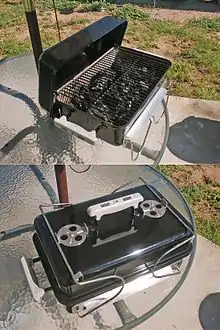
The portable charcoal grill normally falls into either the brazier or kettle grill category. Some are rectangular in shape. A portable charcoal grill is usually quite compact and has features that make it easier to transport, making it a popular grill for tailgating. Often the legs fold up and lock into place so the grill will fit into a car trunk more easily. Most portable charcoal grills have venting, legs, and lids, though some models do not have lids (making them, technically, braziers.) There are also grills designed without venting to prevent ash fallout for use in locations which ash may damage ground surfaces. Some portable grills are designed to replicate the function of a larger more traditional grill/brazier and may include spit roasting as well as a hood and additional grill areas under the hood area.
Portable Backpack Grills
These type of grills are super lightweight and portable so they can be fold down and worn inside a regular backpack. Usually, the backpack is provided with the grill. They are the variations of portable charcoal grills.
Hybrids
A hybrid grill is a grill used for outdoor cooking with charcoal and natural gas or liquid propane and can cook in the same manner as a traditional outdoor gas grill. The manufacturers claim that it combines the convenience of an outdoor gas grill with the flavor and cooking techniques of a charcoal and wood grill.
In addition to providing the cooking heat, the gas burners in a hybrid grill can be used to quickly start a charcoal/wood fire or to extend the length of a charcoal/wood cooking session.
Some of the newer hybrid stoves cater more towards the emergency preparedness/survivalist market with the ability to use propane, charcoal or wood. Generally, they have a propane burner that can be removed and charcoal or wood substituted as the fuel source. Many have features similar to the portable charcoal grill with a volcano shaped cooking chamber for efficiency, the ability to be folded or collapsed for a smaller footprint and a carrying case for easy portability.
Commercial grills
A commercial barbecue typically has a larger cooking capacity than traditional household grills, as well as featuring a variety of accessories for added versatility. End users of commercial barbecue grills include for-profit operations such as restaurants, caterers, food vendors and grilling operations at food fairs, golf tournaments and other charity events, as well as competition cookers. The category lends itself to originality, and many commercial barbecue grills feature designs unique to their respective manufacturer.
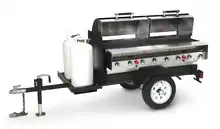
Commercial barbecue grills can be stationary or transportable. An example of a stationary grill is a built-in pit grill, for indoor or outdoor use. Construction materials include bricks, mortar, concrete, tile and cast iron. Most commercial barbecue grills, however, are mobile, allowing the operator to take the grill wherever the job is. Transportable commercial barbecue grills can be units with removable legs, grills that fold, and grills mounted entirely on trailers.
Trailer mounted commercial barbecue grills run the gamut from basic grill cook tops to pit barbecue grills and smokers, to specialized roasting units that cook whole pigs, chicken, ribs, corn and other vegetables.
Parts
Many gas grill components can be replaced with new parts, adding to the useful life of the grill. Though charcoal grills can sometimes require new cooking grids and charcoal grates, gas grills are much more complex, and require additional components such as burners, valves, and heat shields.
Burners
A gas grill burner is the central source of heat for cooking food. Gas grill burners are typically constructed of: stainless steel, aluminized steel, or cast iron, occasionally porcelain-coated.
Burners are hollow with gas inlet holes and outlet 'ports'. For each inlet there is a separate control on the control panel of the grill. The most common type of gas grill burners are called 'H' burners and resemble the capital letter 'H' turned on its side. Another popular shape is oval. There are also 'Figure 8', 'Bowtie' and 'Bar' burners. Other grills have a separate burner for each control. These burners can be referred to as 'Pipe', 'Tube', or 'Rail' burners. They are mostly straight since they are only required to heat one portion of the grill.
Gas is mixed with air in venturi tubes or simply 'venturis'. Venturis can be permanently attached to the burner or removable. At the other end of the venturi is the gas valve, which is connected to the control knob on the front of the grill.
A metal screen covers the fresh air intake of each venturi to keep spiders from clogging the tube with their nests.
Cooking grate
Cooking grates, also known as cooking grids, are the surface on which the food is cooked in a grill. They are typically made of:
- Stainless steel - usually the most expensive and longest-lasting option, may carry a lifetime warranty
- Porcelain-coated cast iron - the next best option after stainless steel, usually thick and good for searing meat
- Porcelain-coated steel - will typically last as long as porcelain-coated cast iron, but not as good for searing
- Cast iron - more commonly used for charcoal grills, cast iron must be coated with cooking oil between uses to protect it from rusting
- Chrome-plated steel - usually the least expensive and shortest-lasting material
Cooking grates used over gas or charcoal barbecues will allow fat and oil to drop between the grill bars. This can cause the fat or oil to ignite in a 'flare-up', the flames from which can blacken or burn the food on the grate. In an attempt to combat this problem, some barbecues are fitted with plates, baffles or other means to deflect the dripping flammable fluids away from the burners.
Rock grate
Rock grates are placed directly above the burner and are designed to hold lava rock or ceramic briquettes. These materials serve a dual purpose - they protect the burner from drippings which can accelerate the deterioration of the burner, and they disperse the heat from the burner more evenly throughout the grill.
Heat shield
Heat shields are also known as burner shields, heat plates, heat tents, radiation shields, or heat angles. They serve the same purpose as a rock grate and rock, protecting the burner from corrosive meat drippings and dispersing heat. They are more common in newer grills. Heat shields are lighter, easier to replace and harbor less bacteria than rocks.
Like lava rock or ceramic briquettes, heat shields also vaporize the meat drippings and 'infuse' the meat with more flavor.
Valves
Valves can wear out or become rusted and too difficult to operate requiring replacement. A valve is unlike a burner, a replacement valve usually must be an exact match to the original in order to fit properly. As a consequence, many grills are disposed of when valves fail due to a lack of available replacements.
If a valve seems to be moving properly, but no gas is getting to the burner, the most common cause for this is debris in the venturi. This impediment can be cleared by using a long flexible object.
Cover
A barbecue cover is a textile product specially designed to fit over a grill so as to protect it from outdoor elements such as sun, wind, rain and snow, and outdoor contaminants such as dust, pollution, and bird droppings.
Barbecue covers are commonly made with a vinyl outer shell and a heat-resistant inner lining, as well as adjustable straps to secure the cover in windy conditions. The cover may have a polyester surface, often with polyurethane coating on the outer surface, with polyvinyl chloride liner.
Indoor grills
While indoor live-fire cooking can be dangerous without heavy-duty ventilation, it is possible to simulate some of the effects of a live-fire grill with indoor equipment. Among the simplest designs is a steel or cast iron griddle, often featuring raised ridges to produce sear marks and allow fat to run off, which is placed on top of an oven hob. An ordinary frying pan can also be used.
See also
References
- McDougall, Len. (2010). The Self-Reliance Manifesto : Essential Outdoor Survival Skills. Skyhorse Publishing, Inc. ISBN 978-1-62873-300-6. OCLC 855969146.
- "A brief history of the bbq grill". PM. Retrieved 2015-04-28.
- "Adaptations of Barbecue".
- "Food Network's Brief History of Grilling". Foodnetwork.com. Retrieved 2011-09-02.
- "About.com's History of Barbecue". Bbq.about.com. 2011-03-02. Retrieved 2011-09-02.
- Slater, Dashka (2014-09-26). "Who Made That Charcoal Briquette?". The New York Times. ISSN 0362-4331. Retrieved 2017-09-10.
- "NY Times Obituary for George Stephen". The New York Times. 1993-02-16. Retrieved 2011-09-02.
- Mauer, Don (2006). The Complete Idiot's Guide to Grilling. USA: Penguin Group. pp. 13–14. ISBN 1-59257-481-5.
- Popular Mechanics, June 1957, page 97.
- Cart. "60 years of rich history! » LazyMan Gourmet Grills". Lazyman.com. Retrieved 2015-02-01.
- Mayer, Lisa (December 2007). "A sizzling array of new barbecue/grills awats dealers and consumers in the coming year". Hearth and Home Magazine.
- "Infrared fires up backyard barbecues". msnbc.com. 2007-05-25. Retrieved 2018-01-16.
- Mariani, John; Rama, Marie (2009-03-11). Grilling For Dummies. John Wiley & Sons. ISBN 9780470504123.
- Mariani, John F., author. The encyclopedia of American food and drink. ISBN 1-78539-121-6. OCLC 926273681.CS1 maint: multiple names: authors list (link)
- "95/00136 Process for clean-burning fuel from low-rank coal". Fuel and Energy Abstracts. 36 (1): 9. January 1995. doi:10.1016/0140-6701(95)95380-9. ISSN 0140-6701.
- Stines, Michael H. (2012-07-11). Mastering Barbecue: Tons of Recipes, Hot Tips, Neat Techniques, and Indispensable Know How. p. 13. ISBN 9781607744566.
External links
| Wikimedia Commons has media related to Grills. |
| Look up barbecue or BBQ in Wiktionary, the free dictionary. |
